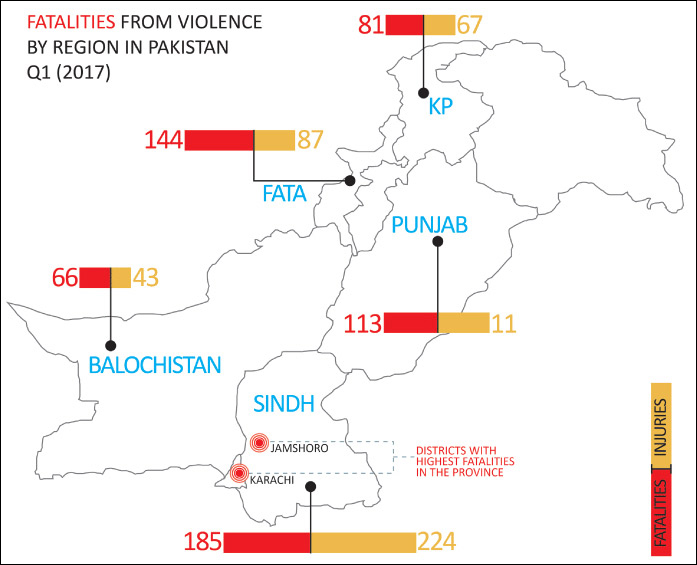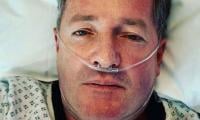‘Deaths by violence saw sharp rise in first quarter’
Think tank report cites Sehwan suicide attack contributing factor in surge in bloodshed in Sindh
A report of an Islamabad-based security think tank shows that Sindh is the only province of the country where fatalities from violence have suddenly increased during the first quarter of this year.
The quarterly report issued by the Centre for Research & Security Studies (CRSS), however, states that the other provinces show a decline in violence-related casualties, when compared to data from last year’s corresponding period.
While ongoing military operations against proscribed militant outfits, such as the Tehreek-e-Taliban Pakistan (TTP) and the Laskhar-e-Jhangvi (LeJ), have forced terrorists to go into hiding, the Islamic State (or Daesh) has shown its presence in Sindh and Balochistan by claiming major suicide attacks on two Sufi shrines, adds the CRSS report.
During the first three months of the current year, there were 1,129 reported casualties – 594 dead and 535 wounded – across Pakistan. Regionally, Sindh is the most violent region, followed by Fata, Punjab and Balochistan. Sindh is the only province to witness a rise in violence-related casualties.
Unlike in the past, Karachi is not the principal factor in the rise in the rate of homicides, Muhammad Nafees, a Karachi-based security expert associated with the CRSS, told The News.

The February 16 suicide attack inside the shrine of Lal Shahbaz Qalandar in Sehwan, which left more than 90 people dead, is the major incident that contributed to the surge in violence in Sindh.
Overall, Sindh had 409 reported casualties, 89 of which occurred in Karachi, says the report. Compared with the number of fatalities recorded in the first quarter of last year, the fatalities were 20 per cent higher. February 2017 had the highest number of fatalities.
However, the report notes a marked decline in the number and percentage of militant and criminal fatalities. Civilians accounted for 65 per cent of the total fatalities, compared to 24 per cent recorded in the first quarter of 2016. The percentage of security personnel’s fatalities also declined.
Among the outlaws who lost their lives during the first quarter, the highest number was of robbers, followed by militants associated with the TTP, the LeJ and al Qaeda, adds the report.
“Incidents of robbery-related fatalities are constantly rising in Karachi, and so are the lynching incidents. The emerging trend is dangerous and worrisome,” said Nafees.
Of the 17 robbers who lost their lives during the first three months, 14 were killed in shoot-outs with law enforcement agencies and three of them were lynched by mobs when they were caught red-handed.
Two robbers were beaten to death in the Landhi and Korangi neighbourhoods while one of them was burnt alive in Korangi. One female and three male robbers were also severely beaten up by mobs in the Korangi and Orangi localities.
The Sehwan shrine attack shows the presence of the IS, a claim often denied by the government. Nafees said that recent arrest of Noreen Laghari, a student of Jamshoro’s Liaquat University of Medical Health Sciences who had gone missing, also showed that the IS had been recruiting from Sindh.
In the final quarter of last year, the IS had claimed responsibility for the November 12 suicide attack at the Shah Noorani shrine in Balochistan’s Khuzdar district.
-
 Nobel Foundation Reaffirms Its Core Responsibility To ‘safeguard The Dignity Of The Nobel Prizes’
Nobel Foundation Reaffirms Its Core Responsibility To ‘safeguard The Dignity Of The Nobel Prizes’ -
 Prince William, Kate Middleton Warned Of Meghan Markle’s UK Return
Prince William, Kate Middleton Warned Of Meghan Markle’s UK Return -
 Melissa Leo Reveals How Winning An Oscar Made Things Worse
Melissa Leo Reveals How Winning An Oscar Made Things Worse -
 Piers Morgan In Hospital: Here's Why
Piers Morgan In Hospital: Here's Why -
 IPhone 18 Pro Leaked: New Design Reveals Radical Corner Camera Layout
IPhone 18 Pro Leaked: New Design Reveals Radical Corner Camera Layout -
 Kung Fu Legend Siu-Lung Leung Passes Away At 77
Kung Fu Legend Siu-Lung Leung Passes Away At 77 -
 Kim Kardashian To Remove Ex Kanye West From Her Kids' Names
Kim Kardashian To Remove Ex Kanye West From Her Kids' Names -
 Queens Mother Arrested After Abducting Child From Court-ordered Visit
Queens Mother Arrested After Abducting Child From Court-ordered Visit -
 Sarah Ferguson Ready To ‘spread Her Wings’ After Separating From ‘disgraced’ Andrew
Sarah Ferguson Ready To ‘spread Her Wings’ After Separating From ‘disgraced’ Andrew -
 Finn Wolfhard Shares How Industry Views Him Post 'Stranger Things'
Finn Wolfhard Shares How Industry Views Him Post 'Stranger Things' -
 Dylan O'Brien Gets Nostalgic After Reunion With Old Friend
Dylan O'Brien Gets Nostalgic After Reunion With Old Friend -
 UK Doctors Warn Screen Time Is Harming Children’s Health
UK Doctors Warn Screen Time Is Harming Children’s Health -
 Meghan Markle To Get Police Protection In UK If Travelling With Archie, Lilibet
Meghan Markle To Get Police Protection In UK If Travelling With Archie, Lilibet -
 Spencer Pratt Expresses Hope For Taylor Swift, Travis Kelce's Wedding Invite
Spencer Pratt Expresses Hope For Taylor Swift, Travis Kelce's Wedding Invite -
 Evan Peters Makes Unexpected Confession About 'American Horror Story' Season 13
Evan Peters Makes Unexpected Confession About 'American Horror Story' Season 13 -
 Kentucky Grandmother Arrested After Toddlers With Broken Skulls, Ribs
Kentucky Grandmother Arrested After Toddlers With Broken Skulls, Ribs



